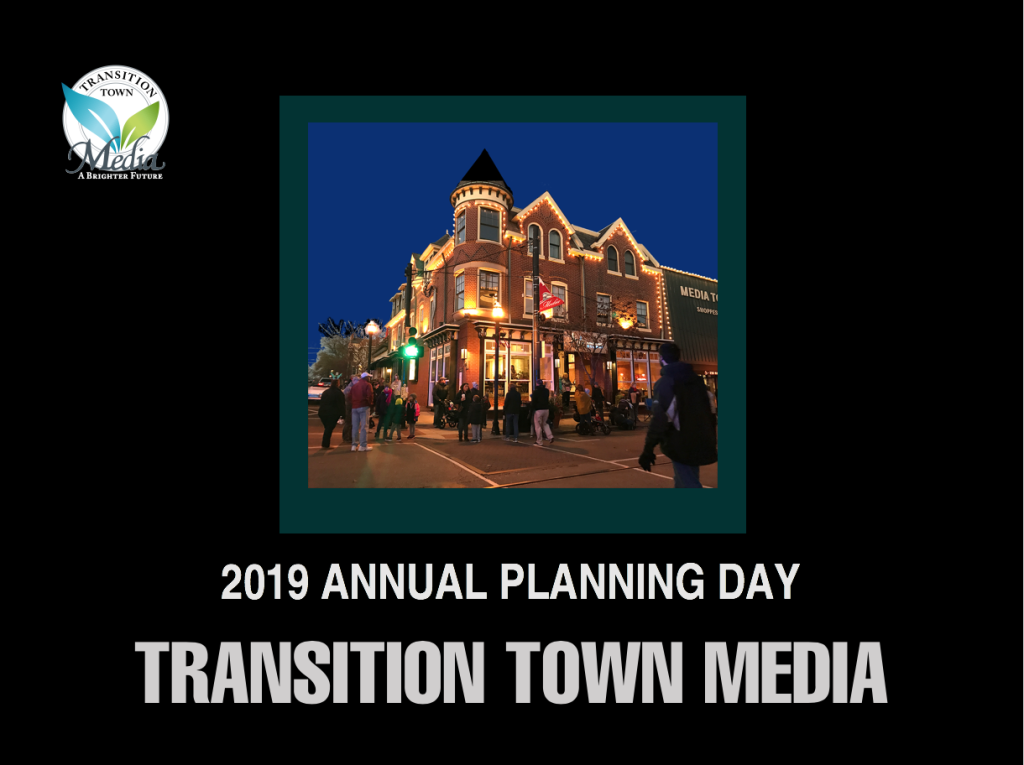
Every year, Transition Town Media (TTM) starts off with a planning session. This year was special for two reasons. First, 2019 is our tenth year of being an official Transition Town—quite a milestone! And second, I had reached the end of my second 3-year term as President of TTM, the term limit for our officers, so after six years of my being at the helm, TTM was getting a new President! For this auspicious occasion, I wrote this introduction to what Transition is all about, inspired by all I’ve learned in the past 10 years from wonderful mentors such as Rob Hopkins and Sophy Banks of the Transition Movement, Richard Heinberg of Post Carbon Institute (sometimes called the Think Tank of the Transition Movement), and Charles Eisenstein, author of The More Beautiful World Our Hearts Know is Possible. I hope you enjoy reading it!
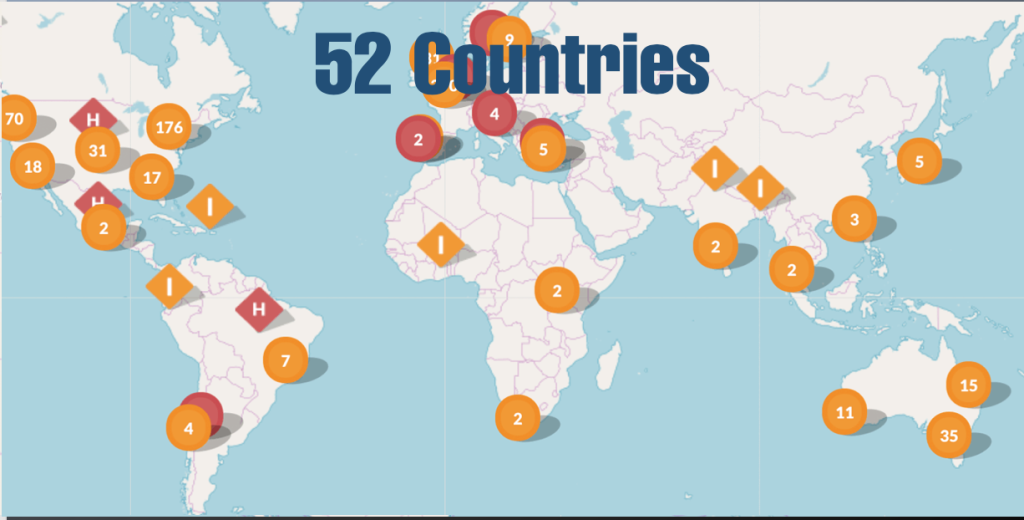
Transition Town Media is part of a worldwide movement—there are Transition Towns like Media’s in 52 countries, in all parts of the world. They are each very autonomous, each one chooses what they want to focus on, what projects they want to take on, based on what calls to them and what makes sense for their particular community. They’re autonomous but strongly interrelated and connected by a very supportive network. Transition Network, in the UK, is the central hub. Transition US is our National Hub and it belongs to a network of National Hubs. Media also belongs to the Mid-Atlantic regional group of Transition Towns. Each of these levels supports and is supported by the others—exchanging stories of what’s worked for them, getting help or advice when something’s not working well, getting inspired by each other’s ideas.
So, Transition is a movement of ordinary, everyday people like you and me who come together and do extraordinary things. It’s very much a grass-roots, bottom-up movement made up of passionate volunteers. It’s self-organizing and organic. It can sometimes be a little messy, chaotic even.
It’s also lots of fun. The idea is to unleash the collective genius and enthusiasm of our community members to reimagine and rebuild our world—to co-create a resilient, thriving, localized, low-carbon world together.

It’s hard to describe Transition because it’s very broad-based. Some might say it’s an environmental movement, fighting climate change, getting rid of fossil fuels, or it’s a community-building movement, or a social justice movement—and yes, it’s all of those things. But it’s different from most non-profits because it doesn’t just try to fix the fossil fuel problem or the climate change problem or the economic inequity problem. It takes a systems view, sees the interrelatedness of all these problems, and goes after the root cause.
You might think fossil fuel use is the root of the problem. But fossil fuels are just an enabler, an accelerator. They have given us enormous power and a wild array of useful, convenient things, many of which we’ve gotten quite attached to. They’ve made us feel so rich that we didn’t have to think about the consequences of using them so profusely. We can buy anything, without thinking about where it came from, who made it and how, or where it goes when we throw it away.
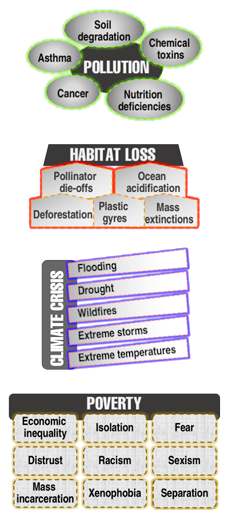
Unfortunately, there are consequences, and they’re becoming more difficult to ignore. There’s pollution of course which has poisoned the air we breathe and the water we drink, with a myriad of health consequences. There’s the soil degradation from growing mono-crops on huge farms, which diminishes the nutrition of the food we eat and our overall well-being. We’ve also destroyed countless ecosystems, the habitat of many of our fellow creatures leading to mass extinctions of many animals and birds that we share the planet with, and the pollinators that are crucial to our existence. Then, of course, the climate is radically changing, causing untold damage throughout the world. Our social systems are also in crisis—marred by poverty and lack of opportunity for many to realize and express their dreams and their gifts. Our economy is unsustainably skewed with a very few extremely wealthy folks and a vast number struggling to get by. It also has become extremely impersonal—we can easily buy things now from people we don’t know, often without leaving our house or interacting with another human being. We live in fear and distrust of our neighbors, feelings expressed in racism, xenophobia, mass incarceration, and border walls—increasing our sense of isolation, even while we crave connection and a sense of belonging.
So, it’s a lot more than fossil fuels—it’s the mindset, the world view that has made all this possible. What makes Transition unique is that it takes into account this bigger picture and looks for the root
Instead of focusing on what we oppose, like stopping fossil fuel use or shutting down pipelines or coal plants—all efforts that are extremely important and which we heartily support—but instead of focusing on what we oppose, we start by reimagining what kind of world we’d really like to live in. What would the air smell like if it were pollution-free? What would the food taste like if were grown with clean water and healthy soil? Wouldn’t it be nice to have green spaces everywhere we went? What would it feel like to walk down the street and not have it clogged with cars? To know and trust the people we meet, regardless of whether we agree with them or not? How would our community thrive if everyone could do work that gave them a sense of belonging, contributing, fulfilling their potential?
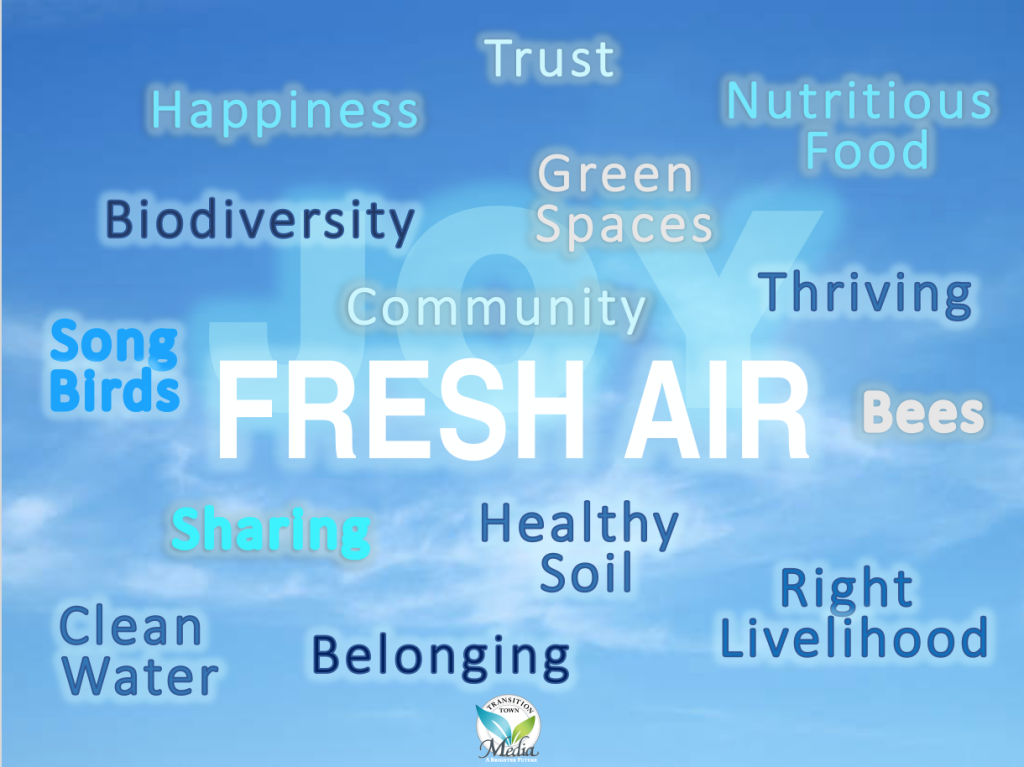
And having imagined this better world, we jump in and start re-building it—starting with what we can do right now to support a strong local ecology based on care for the earth and its living things, a strong local economy that values people and their gifts from which they can make a good living and a good life, and a strong local resilient culture based on caring for each other and working together for our common good. A world, in short, that more closely mirrors our real values. A world that, we believe, leads to a better life, one that’s more connected, more creative, more joyful because it’s been filled with things that matter, things that bring us joy.
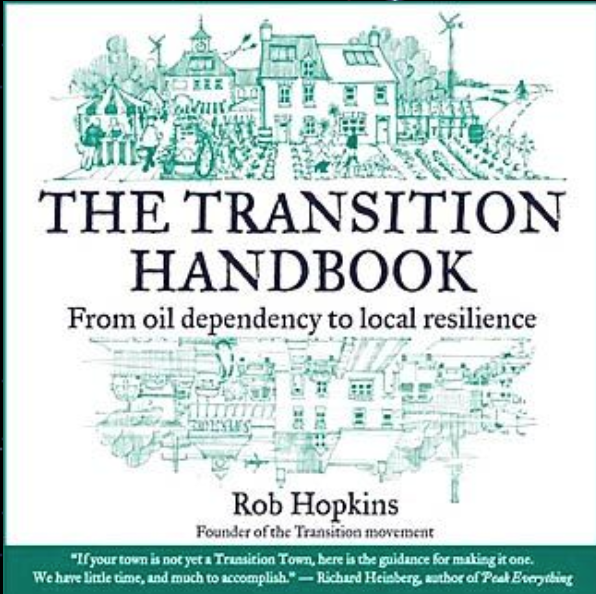
The original Transition Handbook described this work as engaging our head, heart, and hands. In other words, we start with assessing the situation—what’s really going on in the world. Then we also get in touch with how that’s affected us—the inner transition view. How have we been wounded by what we’ve done to the earth? How have we sold out our values for money and convenience?

And then we get to work, transforming the worldview that got us here into a new story of inter-relatedness, of
One of my favorite cartoons, by Joel Pett, depicts a Climate Summit stage with a presenter, and an audience focusing on issues such as energy independence, preserving rainforests, green jobs, livable cities, renewables, clean air & water, healthy children. A climate change denier standing at the back of the room exclaims: “What if it’s a big hoax and we create a better world for nothing?”
To see the slides that went along with this talk, click here.
Read about what’s going on in the wider Transition Movement—regionally, nationally, and internationally—from Aleisa’s talk. She has numerous links to videos and websites that you can follow to learn more about any of the entities, working groups, and projects she describes.
And finally, if you’d like to know about all that we accomplished in 2018, check out the Year-in-Review.
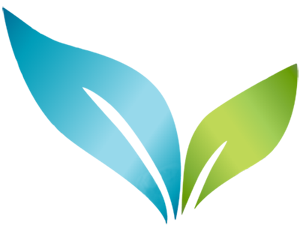

Leave a Reply